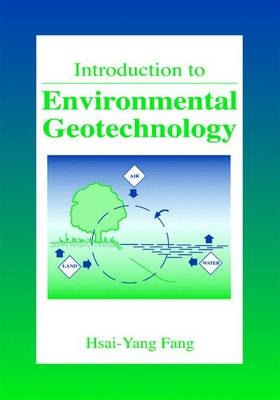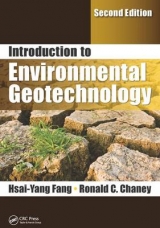
Introduction to Environmental Geotechnology
Crc Press Inc (Verlag)
978-0-8493-8288-8 (ISBN)
- Titel erscheint in neuer Auflage
- Artikel merken
For everything from applications of particle energy field theory to landslide prevention and desert water supply, Introduction to Environmental Geotechnology provides a complete picture of the fascinating and rapidly growing field of environmental geotechnology. Unique in scope, this new book covers the full interdisciplinary spectrum of the discipline, including soil science, physical chemistry, mineralogy, geology, ground pollution, and others. This is the first book to incorporate and summarize the discipline for students, teachers, and practitioners. It is a complete text on applied soil engineering, broadly covering:
Introduction
Definition. Development of Environmental Geotechnology. Aims of Environmental Geotechnology. Environmental Cycles and Their Interaction with Geotechnology. Man-Made Environment. Acid Rain and Acid Drainage. Environmental Geotechnical Problems. Pollution Processes and Soil-Pollution Interaction. Methods for Analysis of Environmental Geotechnical Problems. Scope and Organization of the Text. Summary. Problems.
Particle Energy Field Theory and Its Application
Introduction. The Concept of Particle Energy Field Theory. Energy, Energy Field and Particle Energy Field. The States of Aggregation of Idealized Particles. Crystal - A True Solid. Granular Particles and Their Packing Characteristics. Chemical Fundamentals. Phenomena of Solid-Liquid-Gas at Interface. Particle Behavior Under Load - Mechanical Energy Field. Multi-Media Energy Field. Justification for Application to Geotechnology. Summary. Problems.
Nature of Soil and Environment
Soil as a Natural Genetic System. Soil as a Polydisperse System.
Soil Texture, Strata, Horizon and Profiles. Identification and Classification Systems of Soil. USDA Soil Classification System. Chemical Composition of Natural Soil and Clay Fraction. Granular Soils. Identification and Characterization of Contaminated Soils. Classification of Contaminated Soils. Dust: Microscopic Debris. Suspension: Dust in the Water. Summary. Problems.
Soil Technology
Introduction. Soil Mineralogy. Structural Units of Soils. Size and Shape Measurements. Particle Bonds and Linkages. Inter-Particle Energies and Forces. Particle Arrangement and Clay Structures. Ion Exchange Reaction in Soil-Water Systems. The Clay-Water-Electrolyte System. Characteristics and Structures of Some Typical Clay Minerals. Hydrophobic and Hydrophillic Soils. Homoionic Soil: Pure Soil. The Man-Made Soil. Summary. Problems.
Soil-Water-Air Interaction in the Environment
Introduction. Nature of Water. Properties of Water and Water Substances. Solutions, Compounds, Mixtures and Electrolytes. Types and Sources of Waters. Electrochemical Characteristics of Soil-Water System. Soil-Water Interaction in the Thermal Energy Field. Soil-Water Interaction in the Electric Energy Field. Geomorphic Processes (Aging Process). Corrosion Process. Effect of Bacteria on Behavior of Soil-Water System. Sensitivity of Soil to Environment. Soil-Water-Air Interaction. Summary. Problems.
Shrinkage, Swelling and Cracking Characteristics of Soil
Introduction. Shrinkage Characteristics. Swelling Characteristics. Sorption Characteristics. Adsorption Phenomena. Cracking Phenomena and Mechanisms. Tensile Characteristics of Soil. Fracture Characteristics of Soil. Summary. Problems.
Hydraulic Conductivity and Mass Transport Phenomena
Introduction. Capillarity. Hydraulic Conductivity. Infiltration, Percolation and Retention. Mass Transport Phenomena. Osmotic and Reversed Osmotic Phenomena. Soil-Water Suction and Diffusivity. Moisture Migration. Diffusion Phenomena. Water Movement in Vadose Zone. Summary. Problems.
Thermal Properties of Soils
Introduction. Characteristics of Heat and Heat Sources. Heat Transfer Process and Measurable Thermal Parameters. Soil-Heat Interaction. Thermal Conductivity and Resistivity of Soil. Effects of Heat or Temperature on Soil Behavior. Frozen and Thawing Soils. Characteristics of Snow. Summary. Problems.
Electrical Properties of Soil
Introduction. Characteristics of Particles and Electricity. Measurable Parameters in Soil-Water-Electricity System. Fundamentals of Soil-Electrochemistry. Electrolytes and Electrical Reactions. Electric Properties of Soil, Water and Rock. Dielectric Constant of Soil-Water System. Electric Conductivity and Electrokinetic Phenomena. Ground Improvement by Electrokinetic Process. Soil Decontamination by Electrokinetic Process. Electrophoresis and Electro-Migration. Electro-Chemical Process. Multi-Energy Effect on Soil-Water System. Summary. Problems.
Radiation Effects on Water, Soil and Rock
Introduction. Characteristics of Radioactivity. Radioactive Decay Process. Uranium and Radium Interaction with Environment. The Noble Gases Family. Environmental Geotechnical Aspects of Radiation. Radioactive and Toxic Radon Gas. Radon Mitigation Methods and Monitoring Techniques. Nuclear Waste Disposal. Utilization of Nuclear Energy for Construction Applications. Other Applications and Problems. Summary. Problems.
Compressibility and Stress-Strain-Strength of Soils
Introduction. Soil Compaction (Densification). Dynamic Consolidation (Dynamic Densification). Consolidation. Normally and Overconsolidated Clays. Pre-Failure and Failure Conditions of Soil. Stress-Strain-Strength Characteristics of Soil. Residual Shear Strength. Soil Dynamics. Blasting Dynamics. Summary. Problems.
Environmental Geotechnical Engineering Applications
Introduction. Load-Environmental Factor Design Criteria. Soil-Structure versus Structure-Soil Interactions. Load, Factor of Safety and Allowable Conditions. Bearing Capacity of Ground Soil. Lateral Earth Pressures. Friction Forces and Angles Between Two Materials. Pile Foundations. Underwater Foundation Problems. Grouting and Injection Processes. Summary. Problems.
Problematic Soils and Rocks
Introduction. Shales and Weathered Rocks. Residual Soils. Expansive Clays. Organic Soils. Karst Region (Sinkhole). Loess (Aeolian Deposits). Dispersive Clays. Laterite Soils. Lacustrine Sediments and Varved Clays. Saline and Alkali Soils. Bentonite Clays. Tephra, Coral and Sea Shells. Summary. Problems.
Wetlands, Coastal Margins and Soil Erosion Problems
Wetlands. Land and Coastal Margins. Beaches and Beach Erosion. Saltwater Intrusion, Estuaries, and Green-House Effect. Marine Sediments and Sea Floor Problems. Dredging and Dredging Material. Soil Erosion. Water Erosion. Wind Erosion. Erosion Control in Construction Areas. Summary. Problems.
Ground Surface Subsidences
Introduction. Characteristics and Classifications of Ground Subsidence. Mechanisms and Phenomena of Ground Subsidence. Ground Subsidence Due to Natural Causes. Dewatering. Mining Subsidence. Construction Operations. Summary. Problems.
Slope Stability and Landslides
Introduction. Causes and Phenomena Associated with Slope Failures. Progressive Failure and Surface Creep. Slope Stability Analysis Procedures. Effect of Rainfall on Slope Stability. Landslide in Residual Soil and Weathering Rocks. Landslide in Dispersive and Expansive Clay Regions. Landslide in Overconsolidating Clay Areas. Earthquake Trigger Causing Landslides. Slope Stability/Landslides in Adverse Environments. Landslides Prevention, Control and Remedial Actions. Genetic Diagnosis of Landslide and Infrastructural Actions. Landslide Zonation and Microzonation. Summary. Problems.
Solid/Liquid Waste Control and Utilization of Wastes
Introduction. Characteristics of Garbage. Compaction on Landfill. Slope Stability of Landfill. Laboratory Tests on Compacted Garbage. Stability of Garbage During Decomposed Stage. Basic Consider-ations for Design of Waste Control System. Waste Control System Components. Factors Affecting the Stability of Waste Control System. Utilization of Wastes for Engineering Purposes. Summary. Problems.
Arid Lands, Desert and Antidesertification Measures
Introduction. Characteristics of Desert and Desertification. Desert Environments. Characteristics of Desert Soils. Desert Sand-Heat Interaction. Desert Sand-Wind Interaction. Sand Dunes. Desert Sand-Water Interaction. Locating Water Supply Source Based on Preferred Planes Concept. Anti-Desertification Measures. Summary. Problems.
References
Appendices
Symbols. Conversion Factors. Chemical Fundamentals.
| Erscheint lt. Verlag | 24.9.1997 |
|---|---|
| Zusatzinfo | 165 equations; 26 Halftones, black and white; 150 Tables, black and white |
| Verlagsort | Bosa Roca |
| Sprache | englisch |
| Maße | 178 x 254 mm |
| Gewicht | 1361 g |
| Einbandart | gebunden |
| Themenwelt | Naturwissenschaften ► Geowissenschaften ► Geologie |
| Technik ► Bauwesen | |
| Technik ► Umwelttechnik / Biotechnologie | |
| ISBN-10 | 0-8493-8288-2 / 0849382882 |
| ISBN-13 | 978-0-8493-8288-8 / 9780849382888 |
| Zustand | Neuware |
| Haben Sie eine Frage zum Produkt? |
aus dem Bereich



